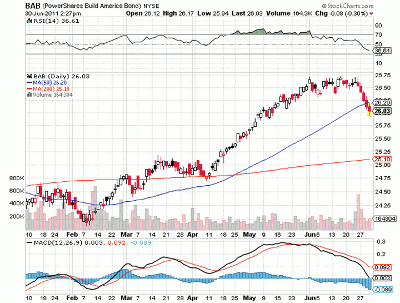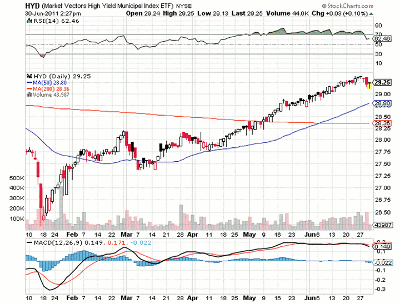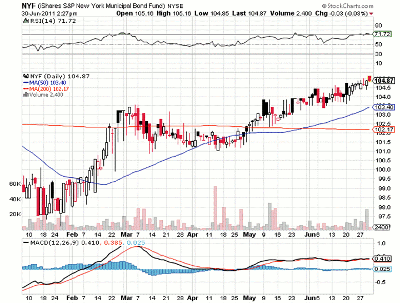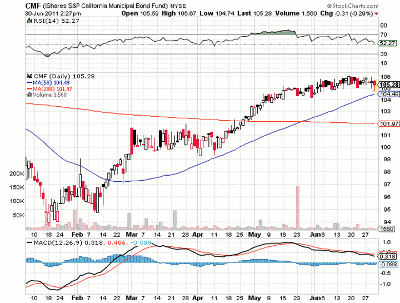Investors who believe the doomsday predictions about municipal bonds—and even those who don't—may find long or short opportunities in these five ETFs, which track various segments of the muni bond market.
According to the ancient Mayan calendar, the world will end in December 2012.
If banking analyst Meredith Whitney is right, the beginning of the end might be right around the corner. Whitney, who rose to prominence after a pessimistic report on Citigroup issued in late 2007 later proved to be painfully accurate, has been zeroed in on the municipal bond sector for some time now as the next market to enter into a freefall.
She first turned heads last year when predicting that between 50 and 100 local governments could default on obligations worth hundreds of billions of dollars–a collapse that would almost certainly be felt throughout global financial markets.
That breakdown in municipal (muni) bond markets so far hasn’t materialized; default rates have been in line with historical averages, and investors who held on to these securities have been rewarded with relatively strong performances. But Whitney hasn’t backed down from her predictions, and in fact believes that coming weeks may see critical developments in muni bond markets.
She’s targeted July 1 as an important date in this ongoing saga. That’s when new state budgets take effect, which may result in reduced aid to localities that have relied on outside aid up until this point to make good on obligations. If that source of liquidity dries up, it could start a string of muni defaults that will accelerate throughout the remainder of the year.
“This is the sad reality of where we are,” Whitney said during an interview on CNBC. “It will sting the sharpest when the states at the beginning of July cut aid off to municipalities.”
It should be noted that not everyone is on the same page as Whitney.
According to a recent research note from analysts at RBC Capital Markets, state employment levels are at their lowest levels since 1999. That seemingly indicates that governments are slashing payrolls in an effort to reel in costs, giving hope that self-imposed austerity measures will be enough to steer clear of a wave of defaults.
S&P’s VP of fixed income also believes that Whitney’s predictions are a bit extreme, noting that actual default stats so far don’t support her bearish outlook on the segment.
With outlooks sharply divided on the short-term outlook for muni bonds, there are a number of ETFs that have seen increased activity and offer ways to access various segments of this fixed income market.
Those who believe Whitney’s arguments hold some water may see attractive short-selling opportunities in some of these names, while those who believe her bearishness is overdone might see attractive entry points in beaten down securities that will eventually recover once the public’s anxiety eases.
iShares S&P National AMT-Free Muni Bond Fund (MUB)
This ETF is the most popular option for investors seeking broad-based exposure to municipal bonds. MUB includes more than 1,300 individual securities from a variety of different issuers. Transportation-related muni bonds account for the biggest slice of holdings (23%), with utilities (21%) and tax revenue bonds (14%) also receiving significant weight in this portfolio.
MUB currently has a distribution yield of about 3.5%, which works out to a tax-equivalent yield of almost 5.4%, assuming a 35% tax bracket.
Here is a daily chart:
NEXT: Four Other Municipal Bond ETFs to Watch
|pagebreak|PowerShares Build America Bond Fund (BAB)
BAB is one of several Build America Bond ETFs, focusing on a segment of the fixed income market that popped up as a result of short-lived legislation aimed at providing liquidity to cash-strapped governments.
Unlike traditional munis, Build America Bonds don’t offer tax-free coupon payments. Instead, the interest obligations are subsidized by the federal government, allowing state and local governments to issue debt at relatively attractive rates.
BAB recently had a distribution yield of about 5.7% and an effective duration of about 11.3 years.
Here is a daily chart:
Market Vectors High-Yield Bond Municipal Bond Fund (HYD)
This ETF focuses on the segment of the muni bond market that exhibits the greatest risk of default, but also offers very attractive current return potential. HYD is linked to an index that has a 75% weight in non-investment-grade muni bond debt and a 25% weight in Baa/BBB rated investment grade debt.
High-yield muni debt may feature a risk/return profile that is very different from other funds in the national munis category; these securities are often issued by non-profit organizations (such as hospitals) or corporate issuers (such as airlines or auto companies) in conjunction with public authorities.
About 22% of HYD’s portfolio is debt issued by health companies and hospitals, with industrial development bonds (17%), special tax bonds (13%), and tobacco bonds (11%) also included.
In exchange for taking on additional risk, investors in HYD get the potential for some handsome yields; the 30-day SEC yield on this fund is currently hovering around 6%, which translates into an effective pre-tax yield of more than 9% for those in the top 35% bracket.
State Street also offers the SPDR Nuveen S&P High Yield Municipal Bond ETF (HYMB), which has a yield profile similar to HYD.
Here is a daily chart:
NEXT: ETFs Tracking New York and California Muni Bonds
|pagebreak|S&P New York AMT-Free Municipal Bond Fund (NYF)
This ETF offers exposure specifically to debt issued by New York municipalities, giving investors looking to fine tune muni bond exposure access to one of the largest segments of the market. NYF has about 175 individual holdings, with the largest allocations going to transportation bonds (25%), tax revenue bonds (21%), and utility bonds (17%).
This fund has a distribution yield comparable to MUB, reflecting the relative riskiness of New York issuers relative to the broader muni bond market.
Here is a daily chart:
S&P California AMT-Free Municipal Bond Fund (CMF)
This ETF offers targeted exposure to another segment of the muni bond market; CMF holds almost 250 municipal debt issues from California municipalities. California has been facing a massive deficit for years and has generally been believed to be one of the least stable states from a fiscal perspective. So it probably isn’t surprising that CMF offers slightly more in the way of yield than NYF or MUB; the distribution yield on this fund is about 3.7%, which works out to a tax-equivalent of 6.3%
Here is a daily chart:
By Michael Johnston of ETFdb.com

























